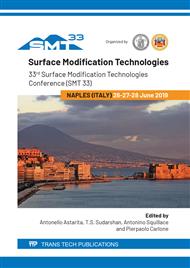[1]
A.M.A. Mohamed, A.M. Abdullah, N.A. Younan, Corrosion behavior of superhydrophobic surfaces: A review, Arab. J. Chem. 8 (2015) 749–765.
Google Scholar
[2]
M. Cui, Y. Shen, H. Tian, Y. Yang, H. Feng, J. Li, Influence of water adhesion of superhydrophobic surfaces on their anti-corrosive behavior, Surf. Coatings Technol. 347 (2018) 38–45.
DOI: 10.1016/j.surfcoat.2018.04.064
Google Scholar
[3]
M. Liu, Y. Zheng, J. Zhai, L. Jiang, † Beijing, Bioinspired Super-antiwetting Interfaces with Special Liquid-Solid Adhesion, Acc. Chem. Res. 43 (2010) 368–377.
DOI: 10.1021/ar900205g
Google Scholar
[4]
K. Liu, M. Zhang, J. Zhai, J. Wang, L. Jiang, Bioinspired construction of Mg-Li alloys surfaces with stable superhydrophobicity and improved corrosion resistance, Appl. Phys. Lett. 92 (2008) 1–4.
DOI: 10.1063/1.2917463
Google Scholar
[5]
Z. Cheng, M. Du, H. Lai, N. Zhang, K. Sun, From petal effect to lotus effect: A facile solution immersion process for the fabrication of super-hydrophobic surfaces with controlled adhesion, Nanoscale. 5 (2013) 2776–2783.
DOI: 10.1039/c3nr34256e
Google Scholar
[6]
Z. Chen, Y. Guo, S. Fang, A facial approach to fabricate superhydrophobic aluminum surface, Surf. Interface Anal. 42 (2010) 1–6.
DOI: 10.1002/sia.3126
Google Scholar
[7]
M. Ruan, W. Li, B. Wang, Q. Luo, F. Ma, Z. Yu, Optimal conditions for the preparation of superhydrophobic surfaces on al substrates using a simple etching approach, Appl. Surf. Sci. 258 (2012) 7031–7035.
DOI: 10.1016/j.apsusc.2012.03.159
Google Scholar
[8]
Y. Guo, Q. Wang, T. Wang, Facile fabrication of superhydrophobic surface with micro/nanoscale binary structures on aluminum substrate, Appl. Surf. Sci. 253 (2011) 5831–5836.
DOI: 10.1016/j.apsusc.2011.01.114
Google Scholar
[9]
X. Li, C. Liu, T. Shi, Y. Lei, Q. Zhang, C. Zhou, X. Huang, Preparation of multifunctional Al alloys substrates based on micro/nanostructures and surface modification, Mater. Des. 122 (2017) 21–30.
DOI: 10.1016/j.matdes.2017.02.092
Google Scholar
[10]
A.C. Geiculescu, T.F. Strange, A microstructural investigation of low-temperature crystalline alumina films grown on aluminum, Thin Solid Films. 426 (2003) 160–171.
DOI: 10.1016/s0040-6090(02)01293-2
Google Scholar
[11]
L. Feng, Y. Che, Y. Liu, X. Qiang, Y. Wang, Fabrication of superhydrophobic aluminium alloy surface with excellent corrosion resistance by a facile and environment-friendly method, Appl. Surf. Sci. 283 (2013) 367–374.
DOI: 10.1016/j.apsusc.2013.06.117
Google Scholar
[12]
T. Liu, S. Chen, S. Cheng, J. Tian, X. Chang, Y. Yin, Corrosion behavior of super-hydrophobic surface on copper in seawater, Electrochim. Acta. 52 (2007) 8003–8007.
DOI: 10.1016/j.electacta.2007.06.072
Google Scholar
[13]
S.T. Yohe, V.L.M. Herrera, Y.L. Colson, M.W. Grinstaff, 3D superhydrophobic electrospun meshes as reinforcement materials for sustained local delivery against colorecal cancer cells, J. Control. Release. 162 (2012) 92–101.
DOI: 10.1016/j.jconrel.2012.05.047
Google Scholar


